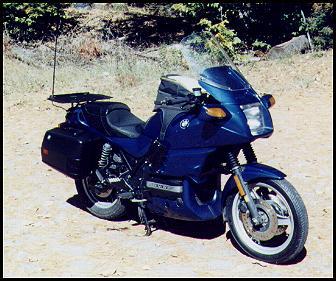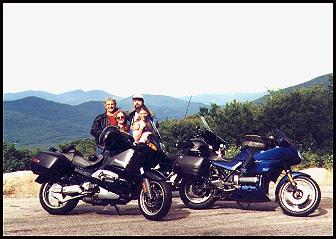
This page is sponsored by:
BMW K75RS Conversion
 |
Like many other BMW riders, I became a fan of the K75 the first time I rode one. It is smooth, solid and as precise feeling as a Swiss watch. I knew from that first ride that one would end up in my garage sooner or later. It's still my favorite of the K-bikes, the power is adequate and the silky way it delivers that power is very satisfying. |
| So somewhere in the middle of the 1995 riding season a low-mileage 92' K75S found its way into the stable and my faithful R100RT was sold just before a five-week cross-country trip. The little K-Bike carried my wife and myself from Vermont down the Blue Ridge into North Carolina, across several states to the Durango National in Colorado, across the Mojave to the coast, back in to Angels Camp for the R.A. National, back out to the coast and around the Olympic Peninsula, through the north central states, around the northern shore of Lake Superior and home. |
It never missed a beat. (In fact, in 64,000 miles the valves have never moved out of adjustment.) In the mountains of Colorado, it definitely struggled two-up with all our gear, but it kept on rolling. The altitude plug definitely helped at the higher elevations. (By the way, if you ride a Jetronic K-bike and haven't yet discovered the altitude plug in your toolkit, try it out the next time you're up high in the mountains.)
I love the bike but have never been thrilled with the fairing. I'm about six feet tall and most of that height starts above my waist, which puts my head up fairly high. In years of experimenting with various bikes, I've found that only two windshield heights will put me in quiet air (even with earplugs and a good Shoei or Arai helmet). The first height is low enough that the air stream begins at mid-chest or below, so that my head is above the turbulent airstream which has been stirred up by the windshield. The second height is about mid-faceshield level, I can see over the windshield edge but most of the wind is pushed over my helmet.
| The standard K75S shield worked fine in hot weather but when more protection was needed, I ran into trouble. The "S" bars on my bike were replaced with "C" bars, which provide a nearly perfect riding position for me. The higher bars combined with my tall trunk, however, create a problem for most aftermarket windshields. |
The nicely shaped Aeroflow was designed for use with standard bars. With the added head height created by the "C" bars, it was very turbulent. The Parabellum for the K75S worked better but the stock "S" fairing doesn't give the unit much to fasten onto. With the very tall (22") shield I needed, the base was overstressed and developed cracks. (Again, the Parabellum was designed for use with stock bars, with a 20" tall or shorter shield, it's fine.) Charlie Perenthian, who had forewarned me of problems with a very tall shield on that system, was very generous and repaired the base for free when it was sent to him for evaluation.
A new fairing, however, was definitely the best solution. The K-RT fairing and riding position are not right for me but the idea of a K75RS was very appealing. The K-RS fairing is much more substantial than the K-S fairing and mounts more solidly. With the K-RS structural design, the Parabellum system not only mounts solidly but actually reinforces the stock fairing; allowing a tall windshield to be mounted without introducing much flex. A call to Charlie confirmed that this combination would probably be able to support the taller shield.
| If you currently own a K75 and are contemplating this project, you may want to first consider whether or not a used K11RS might be a better idea. Even using mostly secondhand parts, this conversion can cost from two to three thousand dollars all told. |
I strongly prefer the triple over the four but if you don't have that preference and you have a relatively recent K75, you could probably trade up to the K11 for the same cost as the conversion. The larger bike option gives much more power at the cost of, in my experience, more weight and vibration. It is also true, however, that the engine heat management on a K11RS is better than on a K75RS.
| Pricing the brand new parts to do this conversion made my heart skip a beat or two, so I searched the ON Flea Market, the Internet and the usual used parts specialists to locate what I needed. It took several months and many phone calls to get everything together. |
Special thanks go to Mark at Re-Psycle BMW and the staff at Berkshire Motor Works who helped locate some of the hard-to-find used parts. Darrell Faulkenberry and Marcus Poisson at Second Wind BMW in Milford, New Hampshire provided various helpful installation hints. Both of the dealerships mentioned have always gone out of their way to help their customers with special projects.
The K75 and K100 tanks differ in shape; the latter is narrower and taller. If a K75 tank is used with a K-RS fairing, the metal/plastic/rubber inner fairing needs to be cut to match the wider tank; this would take a very skilled hand and fabrication of a new edge molding to be get a stock-looking result. I opted instead to swap the K75 for the K100 tank. The internals of each tank are the same and mounting is straightforward although the K100 sidecovers also need to be fitted in place of the stock units.
| The K-RS fairing itself mounts fairly easily as long as two people are working on the job at once. MOA member Steve Kanopka helped tremendously in that department. The main bracket (which should be bought new to ensure straightness) bolts right on. The lower brackets also mount directly into holes, which are already pre-threaded in the K75 engine. |
The middle brackets must be fabricated but it’s a fairly easy job to measure and make them. The instrument cluster bracket must also be notched and re-welded to make the cluster tilt at a slightly more acute angle to clear the inner fairing. The K-RS wiring harness gets connected to the K75 harness (they won't plug into each other) and that's it for modifications. The new fairing provides stock mounting positions for dual Fiamm horns, which provide a big improvement over the stock K75 unit. The K75S belly pan fits under the RS fairing without modifications.
The preload on the fork springs needs to be increased to compensate for the added front end weight so that the total sag is appropriate. I accomplished this using simple spacers and washers. Fork boots, designed for use on the /6 boxers, were added at the same time to help give the fork seals a long life. The Fox shock on the rear has always worked superbly and a K&N air filter has simplified maintenance while giving a slight boost to mid-range power. The Corbin Rumble Seat is very comfortable two-up, even on a very long day. The Top of the Line brand rack (800-782-4686) is well made, works perfectly and provides a good mounting plate for the K40 antenna I use (with a J&M JMCB-7000B citizens band unit) to keep in touch with the chase van while on tour. Baker-Built Air Wings remove much of the heat built up by the KRS lowers; I highly recommend them to all K-RS and K-RT owners who experience "K Bake".
 |
The final product works very well. Essentially, it's very similar to a K100RS with less power but also less weight, less heat build-up, and much less vibration. The extra fairing weight does nothing to help the already top-heavy feeling all the K's have but the K75RS is less tippy than a K75RT. The larger tank does add 15 to 20 miles to the bike's range. |
I've found reliability to be the most important quality of a lead bike used on organized tours and this bike is outstanding in that area.
In the summer, the stock RS shield provides plenty of cooling air to my upper torso and in the spring and fall the solid, quiet and effective Parabellum system adds the necessary extra protection. The net result of all the changes is a bike that I can ride day in and day out in perfect comfort.
Postscript 2/19/00: I did, with some regrets, sell my K75RS with 84,000 miles on it and still running strong. For riders considering buying a K75, I still recommend it highly. Check the splines carefully and then go put 100,000 miles on the bike.